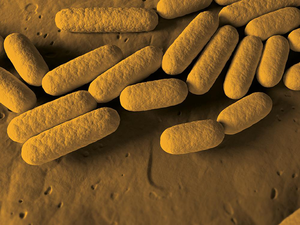Staphylococcus borealis
Classification
Domain: Bacteria
Phylum: Bacillota
Class: Bacilli
Order: Bacillales
Family: Staphyloccocaceae
[Others may be used. Use NCBI link to find]
Species
|
NCBI: [1] |
Staphylococcus S. borealis
Description and Significance
Staphylococcus borealis is bacterial species that is gram positive, coccoid in shape, and can also form clusters. It is a member of the genus Staphylococcus, and it closely related to Staphylococcus haemolyticus which is an opportunistic pathogen that causes disease in patients with foreign body implants or someone with an impaired immunity. While analyzing S. haemolyticus, researchers found five bacterial strains that had different phenotypic and genotypic traits. All five strains are from Tromso, in North Norway so researchers believe it may be adapted to a northern climate. Four strains were isolated from skin swabs and one strain was isolated from blood culture. This indicates the species ability to colonize human skin and potentially penetrate into the blood stream. They believed these strains to be from S. haemolyticus until they did more research due to the differences in other cultures. They proposed that the five strains were a new staphylococcal species called Staphylococcus borealis sp. nov.
Genome Structure
Staphylococcus borealis has 8 strains that have been found. The genome size range was 2,521,961 - 2,797,948 bp, with 2,288 - 2,529 coding sequences. The G+C content of the novel species ranged from 33.54% to 33.80% which is in the range expected for species of the genus Staphylococcus. Researchers identified 74 specific genes and among those genes they found an urease operon. All 8 S. borealis genomes contained capsule-like genes similar to S. haemolyticus and S. aureus capsule genes. The function of these genes still need to be investigated for S. borealis. Since this species is new to being discovered when they cultured it on horse blood agar at 37 degrees Celsius, the S. borealis strains formed smooth, circular, raised or slightly convex colonies reaching 3-5mm in diameter. The 16S rRNA sequence of Staphylococcus borealis 51-48T is under the accession number MT586030.
An interesting feature about S. borealis is that researchers proposed the strains to a novel species of the genus Staphylococcus due to strong phenotypic and genomic justifications that are different from S. haemolyticus. These justifications are:
1. Phylogenetic distance, ANI <95% and inferred DDH <70%
2. Genome comparisons
3. Pigmented phenotype
4. Production of urease
5. Different cell fatty acid composition
Cell Structure, Metabolism and Life Cycle
Staphylococcus borealis is a gram positive bacterium and has a lack of the virulence factor coagulase. The shape of its cells are coccoid and can also form clusters. It has a diameter of 0.65 to 1.23um. The cells have a yellow tint and is similar to S. haemolyticus but the differences can be seen when using supplemented P-agars after 48 hours at 37 degrees Celsius. Since the discovery of S. borealis sp. nov. is so new researchers are still trying to understand how it gains energy and what molecules it produces.
Ecology and Pathogenesis
Staphylococcus borealis is coagulase negative which means it colonizes different niches of the human skin and is a part of the commensal human host microbiota. Since it has a lack of the virulence factor coagulase, this is known for being less pathogenic than S. aureus. In addition, all five S. borealis isolates are all urease positive by biochemical testing and the urease operon was also confirmed genetically. Urease is important for niche adaptation of many bacterial pathogens. When pH increases, it also counteracts the slightly acidic pH caused by lactic acid secreted in the human skin, enabling increased survival on the skin. Researchers thing this might be an important colonizing strategy that S. borealis uses. Researchers are still looking if S. borealis can cause disease.
References
Dæhlen, M. (2020) New staphylococcus bacteria discovered in Norway, Sciencenorway. Available at: https://sciencenorway.no/bacteria-microbiology/new-staphylococcus-bacteria-discovered-in-norway/1777193 (Accessed: November 16, 2022).
Michels, R. et al. (2021) Update on coagulase-negative staphylococci-what the clinician should know, Microorganisms. U.S. National Library of Medicine. Available at: https://www.ncbi.nlm.nih.gov/pmc/articles/PMC8070739/ (Accessed: November 16, 2022).
Pain, M. et al. (2020) “Staphylococcus borealis sp. nov., isolated from human skin and blood,” International Journal of Systematic and Evolutionary Microbiology, 70(12), pp. 6067–6078. Available at: https://doi.org/10.1099/ijsem.0.004499.
Pain, M.C.R. (2020) Exploring the pangenome of staphylococcus haemolyticus. colonisation, hospital adaption, pathogenicity and novel species identification, UiT Munin. UiT The Arctic University of Norway. Available at: https://munin.uit.no/handle/10037/17894 (Accessed: November 16, 2022).
Staphylococcus borealis (no date) Wikiwand. Available at: https://www.wikiwand.com/en/Staphylococcus_borealis (Accessed: November 16, 2022).
Staphylococcus borealis sp. nov. -a novel species isolated from ... - uit (no date). Available at: https://munin.uit.no/bitstream/handle/10037/20308/article.pdf;sequence=5 (Accessed: November 16, 2022).
Author
Page authored by Lindsey Cairey, student of Prof. Bradley Tolar at UNC Wilmington.

